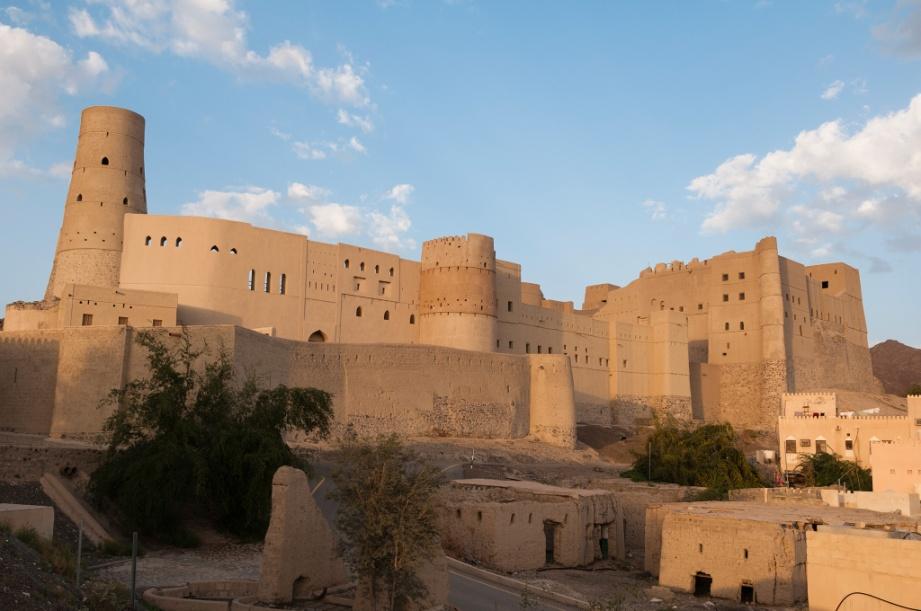A Sultan’s Arabia – Qatar
Muscat, Oman. If you want to see an ultra-rich Arab sheikdom with exotically designed skyscrapers, the world’s most upscale shopping malls featuring indoor streams plied by Venetian gondolas, or fantastically expensive on-the-water condo developments where everyone drives a Ferrari or Rolls – all in the middle of a featurelessly flat desert wasteland – you go to Qatar.
But if you want a more genuine Arabia of Sultan’s palaces, of forts and castles perched on rocky crags, of traditional villages tucked away in mountain fastnesses, of rock pools and grottoes gushing with spring water hidden in secret valleys, a place out of Arabian Nights rather than one of garish ostentatiousness – then you come here to Oman.
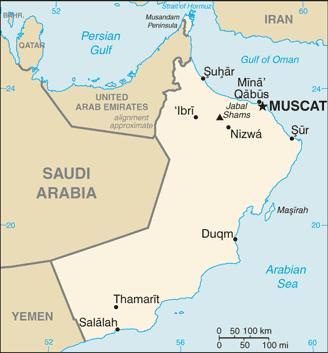
Qatar is where Saudi women go shopping.
Dressed in black cloth burqas that cover everything but their eyes – most of them wear gloves to cover their hands – they spend fortunes on the world’s most expensive haute couture fashion which they get to wear only for each other at women-only parties, or confined at home strictly for their husbands. In malls like this:
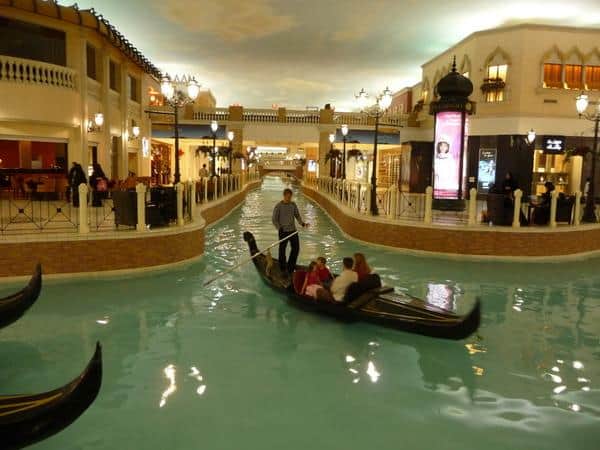
They shop for clothes like this:

Dressed like this:

Qatar is a thumb-like peninsula sticking into the Persian Gulf so wasteland-worthless it was inhabited only by wandering nomad Bedouin tribes for eons and nominally claimed by the Ottoman Turks who ignored it. Then the Brits showed up in the 1860s laying a telegraph cable along the floor of the Persian Gulf for communication with British India.
They made friends with the strongest Bedouin tribe, the Al-Thani, who were happy to rule Qatar as a “protectorate” from the Turks and the Al-Khalifa tribe in Bahrain. Yet the place continued to be a totally impoverished backwater until oil and gas were discovered 100 years later in the 1960s.
Experience the Insider community that takes your international lifestyle to the next level. Download your FREE guide
"18 Steps to Implementing Your Plan B" instantly!
After independence from Britain in 1971, an oil and gas boom took off that has not slowed down. Today, Qatar has the second-highest per capita GDP in the world, $127,000 per Qatari. This wealth is reflected in the capital Doha skyline:
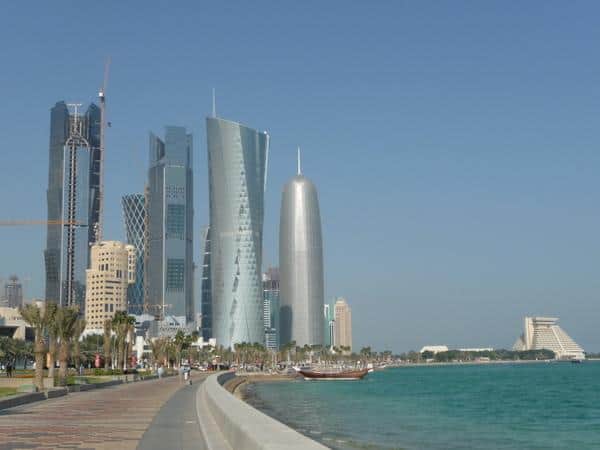
Yet with the wealth comes sterility and inauthenticity in Qatar – so it is a welcome relief to leave Qatar for Oman.
4,000 years ago, the Sumerians (in present-day southern Iraq) called the place Magun or place of copper, for the copper mines they had near Suhar (see map above). The Greeks and Romans called it Omana, evidently “settled place” as opposed to wandering nomads from the local dialect of Suhar.
As Suhar became a coastal hub of trade, it was settled by Mesopotamians, Greeks, Indians, Arabian Bedouins, and especially Persians, who dominated the whole area until folks from the interior of Arabia showed up demanding they accept a newly-invented religion called “Islam” – which means “submission” in Arabic.
One thing the Omanis had going for them was a barrier between them and the Arabs – a vast and labyrinthine complex of mountains, instead of a flat desert. They also knew they didn’t want some Arab horde swarming in to force their Islam upon them at sword-point. So they told the Arabs, okay, we’ll accept your beliefs but on our own terms, we’ll interpret them in our own way. You can leave us alone now.
Thus arose a form of Islam unique to Oman, Al-Ibadhiyah or Ibadism, which remains today as Oman’s state religion. It’s named after one of its early formulators, Abdullah ibn Ibadah (fl. 700 AD).
In addition to a plethora of doctrinal differences separating them from Sunnis and Shias, Ibadists elect their Imams in communal debates and reject the concept of Jihad, or forcing kafirs, unbelievers, to believe as they. Live and let live Islam, we might call it.
It was suited to a cosmopolitan, ethnically-mixed trading society, so they were pretty much left alone to carry on their commerce with the lands around them for the next 800 years until some newcomers showed up.
On July 8, 1497, four ships departed Lisbon, Portugal, commanded by Vasco da Gama (1460-1524) – and on May 20, 1498, landed at Calicut on the Malabar Coast of southwestern India, the first ocean crossing from Europe around Africa’s Cape of Good Hope to India in history.
(Note: Calicut, now ridiculously renamed Kozhikode, is not to be confused with Calcutta, a city built by the British in northeastern India, and now renamed only slightly less ridiculously Kolkata.)
Having pioneered the sea route to India and the spice riches of the East, the Portuguese were determined to keep it for themselves. To secure this end, King Manuel I tasked his military genius, Afonso de Albuquerque (1453-1515) to create a Portuguese Colonial Empire in the Indian Ocean.
Albuquerque’s strategy was to establish forts that would control access to the Indian Ocean via the Atlantic, the Red Sea, and the Persian Gulf. In 1507, he placed forts along the Mozambique coast and at Mombassa in Africa, secured control of the island of Socotra near the entrance to the Red Sea, seized the city of Muscat and gained the submission of Sohar in Oman, then captured the Persian island of Hormuz in the Strait of Hormuz at the entrance to the Persian Gulf.
This, plus the creation of a Portuguese colonial headquarters at Goa on the west Indian coast, infuriated all the powers that thought they should control the region. A massive fleet of over 100 warships was assembled by the Raja of Calicut, the Sultan of Gujarat, the Ottoman Turks and the Sultan of Egypt, plus the Venetians – for the Portuguese had ended the monopoly Venice enjoyed for spices from the East.
On February 2, 1509, this huge war fleet was met by 18 Portuguese men ‘o war commanded by Francisco de Almeida off the spice trading center of Diu (on the Gujarat Peninsula north of Bombay) – and got wiped out.
The Battle of Diu marked the end of Ottoman Turk encroachments into India and the establishment of European colonization in the East. Afonso de Albuquerque was made Governor of Portuguese India, and Oman was to be a Portuguese colony for 143 years.
Then came the Brits. The Portuguese lost their spice trade monopoly with their defeat by the ships of the newly-formed British East India Company at the Battle of Swally (ironically just a few miles east of Diu) in 1612.
As the Brits developed ever-larger trade with India, they became annoyed with Portuguese control of nearby Oman. So in 1646, they made a deal to support the powerful Al-Yaribi tribe in Muscat. This enabled the Yaribis, under Imam Sultan bin Saif al-Yaribi, to revolt and expel the Portuguese from Muscat and all Oman. Then the Brits went back to India and left the Omanis alone.
With captured Portuguese warships and money from trading with the Brits in India, the Yaribis went on a colonial binge of their own. They gained control of the Baluchi Coast from the Persians, and established a colonial capital at Gwadar (now in Pakistan), and began taking over the southern Arabian coast and the east coast of Africa.
In 1698, they kicked the Portuguese out of Zanzibar, who had controlled it for almost 200 years and now retreated to their colony of Mozambique.
Zanzibar (Stone Town in Arabic, an island off the coast of present-day Tanzania) became the center of the Omani slave trade, which made the Omanis immensely wealthy and enabled them to expand their empire.
At the Omani Empire’s peak under Said bin Sultan (1797-1856), the capital of the empire and seat of the sultanate was moved from Muscat to Zanzibar because the slave trade was so enormously lucrative.
Here is the Omani Empire at its fullest. The dashed red/white lines are sea trade routes, black lines/arrows are slaver routes to capture black slaves from the interior:
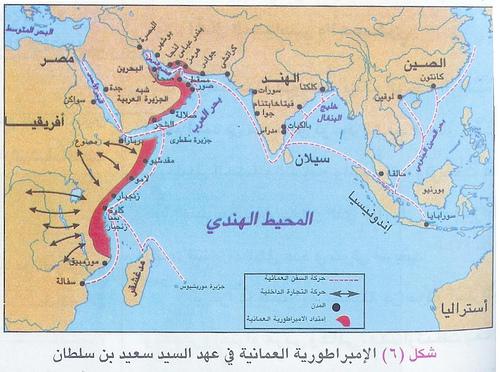
After the death of Said bin Sultan in 1856, the Brits, now moving into East Africa, decided to put an end to the slave trade. The Omani Empire was broken up, the Sultanate moved back to Muscat, and, in 1873, the Sultan forced to sign a declaration abolishing slavery. The Oman economy collapsed and became dependent on British assistance.
That support came in very handy when a collection of crazed Wahhabi fanatics from the Najd wasteland of central Arabia under Abdul Aziz ibn Saud (1876-1953) tried to seize the entire Arabian Peninsula after World War I. The Brits were able to prevent them from incorporating Oman into Saudi Arabia.
Oman remained independent and was never a British colony – but it also was now a poor forgotten backwater ignored by the world.
This retreat from the world was accelerated by Sultan Said bin Taimur (1910-1972), who had ruled Oman since 1932 as a pathological paranoid who refused any modern development for Oman whatever including electricity or telephones. He even retreated personally, leaving Muscat to live in a palace in Salalah, the capital of a remote region in southern Oman called Dhofar.
Dhofar borders Yemen, where the Brits established a colony around the port of Aden in 1837. By the early 1960s, Aden was under assault by Marxist Yemeni guerrillas trained and armed by the Soviet Union and its protégé, Gamel Abdel Nasser of Egypt. The Brits gave up and pulled out of Yemen in 1967, the Soviet colony of the People’s Republic of South Yemen was created, and its guerrilla leaders decided to take over Dhofar.
The Red Chinese now stepped in and armed the Dhofar guerrillas – calling themselves the Popular Front for the Liberation of the Occupied Arabian Gulf or PFLOAG – to the teeth with modern weaponry. The Sultan’s Omani Army had weapons from the 19th century.
The Brits realized this was hopeless under a nutcase of a Sultan, so in July 1970 they arranged a bloodless coup and put his son, Qaboos bin Said, in power. Within hours of the coup, the elite commandos of the British SAS (Special Air Service) had arrived, and a seriously professional counter-insurgency was underway.
Sultan Qaboos and the Brits realized they had a full-on war going and needed allies. Qaboos got help from the Shah of Iran who sent a brigade of troops, King Hussein of Jordan who sent commandos and fighter aircraft, and the British-trained Pakistan Army. Bogged down in Vietnam, we sent nothing. The Marxist-Maoist guerrillas were progressively wiped out until they were dead and gone by the end of 1975.
Sultan Qaboos was well prepared for this, as a graduate of the British Royal Military Academy at Sandhurst and having served in a British Army regiment. He was also well prepared, having travelled and studied all over the world, for transforming Oman from feudal medievalism into a modern and moderate Islamic nation.
The transformation has been truly dramatic. Schools, highways, hospitals all over the country, a vibrant free press – albeit no criticizing the Sultan! – modern ports, close to a million barrels a day oil production, wonderful hotels with great good, great service, and yes, great beer.
There is even an Oman Philharmonic Orchestra that expertly plays the classical music Sultan Qaboos loves.
Ibadi Islam is a moderate, peaceful, hospitable Islam, which is reflected in the gracious friendliness of the Omani people. Everywhere I went I was greeted with a gentle smile. It is also reflected in the pro-West, pro-American foreign policy of Sultan Qaboos. Under him, Oman has become one of America’s staunchest allies, if not the staunchest, in the Moslem world.
This is a marvelous place and I can hardly wait to come back here again. And probably soon – for there is a question mark hanging over Oman.
Sultan Qaboos runs an absolute monarchy. There is such a personality cult around him that Oman has no independence day – instead, the Oman National Holiday is the Sultan’s birthday, November 18. And he has no children, no heir, no successor to the throne. (The worst-kept secret in Oman is that he is a homosexual who keeps a harem of his strikingly handsome and young Royal Palace guards – which is okay in an Islamic country as long as you keep it hidden and never admitted.)
Qaboos turns 77 next month. He may last another 10 years, and I hope he does for Oman’s sake. But a lot of Omanis are getting nervous, and are crossing their fingers over his relatives (the “Ruling Family Council”) picking someone okay to be his successor.
Keep your fingers crossed for Oman – and come here if you ever get the chance. One enticement: Condé Nast Traveler magazine lists The Chedi in Muscat as the Number One spa hotel in the entire world.
That’s only one of Muscat’s fabulous hotels. Here’s the pool at the Shangri-La:
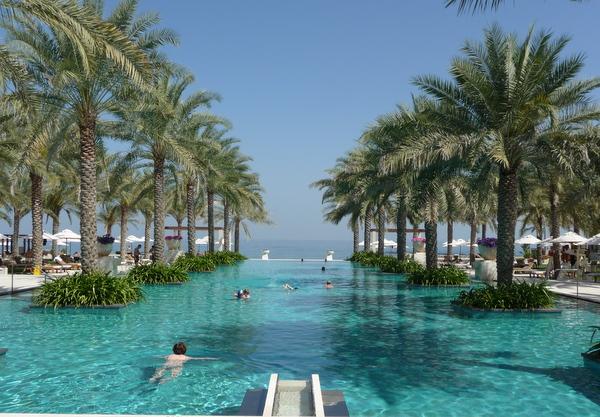
Other enticements. Here’s the old Portuguese fort lit up at night above the Muscat waterfront:
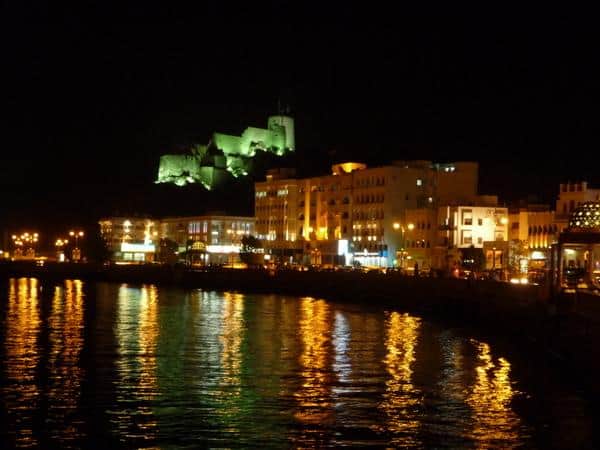
The Sultan’s Palace:
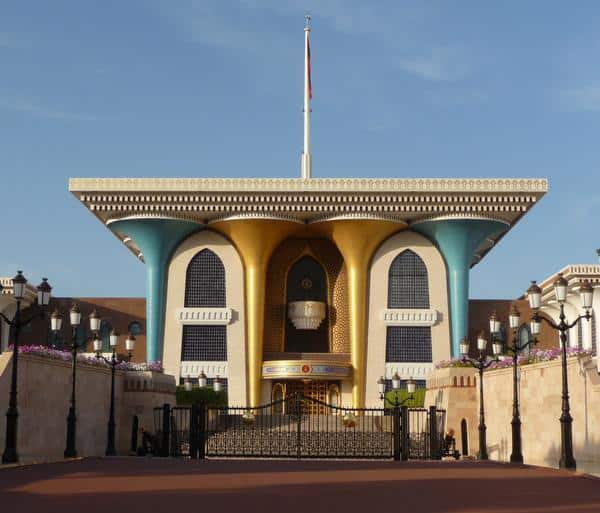
The Wadi Shab where you can swim in total seclusion:
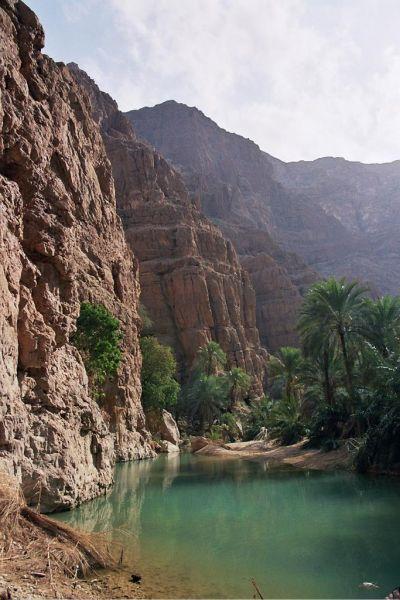
The mountain castle of Rustaq:
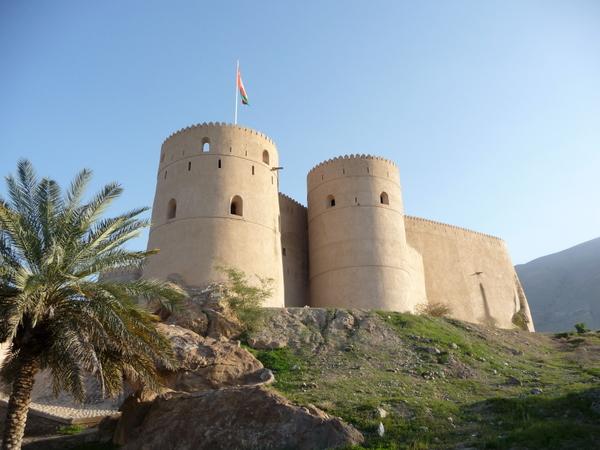
And the fort of Nakhal
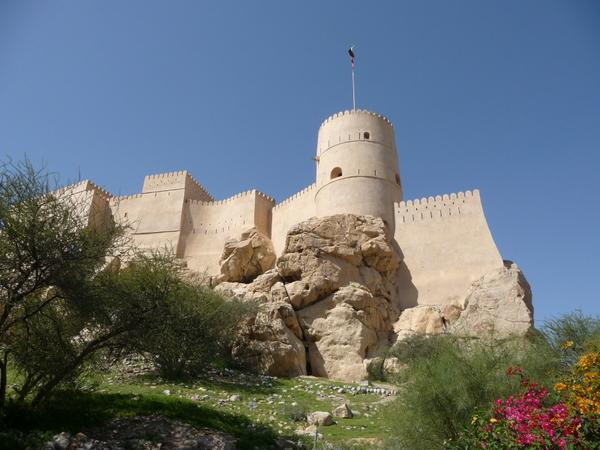
All you have to do is walk through this gate and into a Sultan’s Arabia:
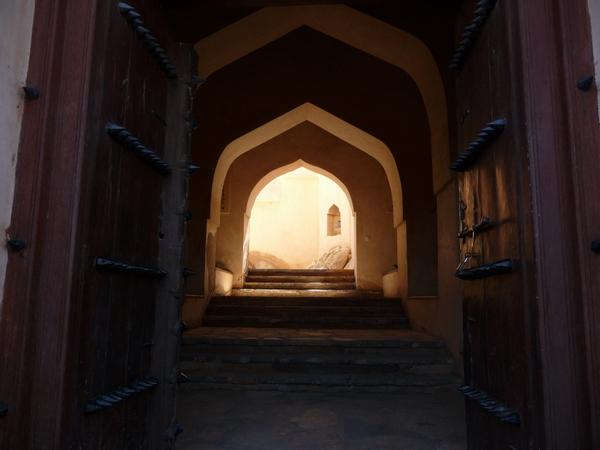
How to pronounce “Qatar” – derived from the Roman name for it, Qatara – is a challenge. You hear it as “guitar,” “cutter,” “gutter,” “kah-tar,” and “kah-tar.” Either the first one or the last seem preferable.
The largest city of New Mexico is not named for him, but for Francisco Fernandez de la Cueva, the 8th Duke of Alburqueque, who as Viceroy of New Spain, founded the Villa de Alburqueque in 1660. Note the missing ‘r’ in the American spelling of the city. Even though Afonso’s name is also missing the ‘r,’ his ancestors originated in the Duke’s town of Albuquerque in the Extremadura of Spain just a couple of miles from the border with Portugal. The meaning is from the Arabic Abu al-Qurk, “father of cork oak.”
Enjoy this podcast from The Expat Money Show – JohnnyFD who talks about moving from the USA and living in Bali and Thailand.
Visit our bookstore to purchase it today! While visiting our bookstore, you may be interested in Escape To The United Arab Emirates, an amazing book about everything UAE.
Are you looking for a comprehensive guide for Dubai? or moving to the UAE? Make sure to check out Escape To The United Arab Emirates, you’ll love it!
©2019 Jack Wheeler – republished with permission
Like Our Articles?
Then make sure to check out our Bookstore... we have titles packed full of premium offshore intel. Instant Download - Print off for your private library before the government demands we take these down!

